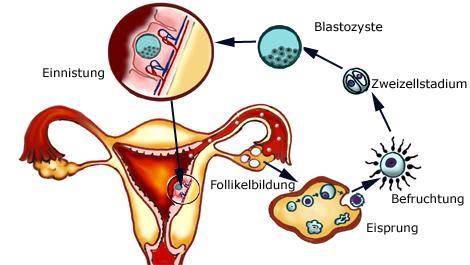Waiting times are normal Most couples will naturally assume that they can have a baby - if theywant to. As unlikely as it is, in fact, to beget a child, many will only become aware after they have tried unsuccessfully for some time.
Human reproduction is extremely vulnerable. A small error in the sperm, egg maturation, fertilization or implantation - and the chances of pregnancy are missed for the next four weeks. Even if all conditions are optimal, are more than 30 percent of women within a monthly cycle pregnant. Experts estimate that every third couple even more than a year waiting. So do not be disappointed if it does not work. Timing is everything The time window is small: only once a month there is an ovulation, and then the egg is only about a day capable of fertilization. Sperm survive in the body of the woman as much as two to five days.Around ovulation - two days before to a day later - you have to witness the best chance of a child. But to catch this time is not easy, because few women know the exact date of her ovulation. As a rule of thumb: Between 9 and 16Day of a 28-day cycle is the most likely to become pregnant.Couples who sleep with each other every three days, save yourself the arithmetic. They catch in each case a fruitful day. Abstinence increases fertility More frequent sex, as well as impaired fertility to less common.With daily ejaculation less sperm in the semen after a short sexual abstinence. Optimal intervals of two to three days. The position during sex play for the conception no difference. On the fertile days, a woman from any form of vaginal intercourse become pregnant. Cervical barrier On most days of the cycle closes a tenacious mucus of the cervix.Only at the time of ovulation, the body is getting ready for male germ cells. The mucus becomes more fluid, and the cervix can happen to the seed. In the cervical mucus, the sperm is now protected even against attacks by the female immune system and can survive for several days. Contractions of the uterus also support sperm migration direction in your fallopian tubes.
Human reproduction is extremely vulnerable. A small error in the sperm, egg maturation, fertilization or implantation - and the chances of pregnancy are missed for the next four weeks. Even if all conditions are optimal, are more than 30 percent of women within a monthly cycle pregnant. Experts estimate that every third couple even more than a year waiting. So do not be disappointed if it does not work. Timing is everything The time window is small: only once a month there is an ovulation, and then the egg is only about a day capable of fertilization. Sperm survive in the body of the woman as much as two to five days.Around ovulation - two days before to a day later - you have to witness the best chance of a child. But to catch this time is not easy, because few women know the exact date of her ovulation. As a rule of thumb: Between 9 and 16Day of a 28-day cycle is the most likely to become pregnant.Couples who sleep with each other every three days, save yourself the arithmetic. They catch in each case a fruitful day. Abstinence increases fertility More frequent sex, as well as impaired fertility to less common.With daily ejaculation less sperm in the semen after a short sexual abstinence. Optimal intervals of two to three days. The position during sex play for the conception no difference. On the fertile days, a woman from any form of vaginal intercourse become pregnant. Cervical barrier On most days of the cycle closes a tenacious mucus of the cervix.Only at the time of ovulation, the body is getting ready for male germ cells. The mucus becomes more fluid, and the cervix can happen to the seed. In the cervical mucus, the sperm is now protected even against attacks by the female immune system and can survive for several days. Contractions of the uterus also support sperm migration direction in your fallopian tubes.
Heavy losses on travel

With the ejaculate pour usually 350 to 400 million sperm in the vagina. The vast majority do, but somewhere along the way fromthe vagina through the cervix and uterus to the fallopian tubes limp.Just create 500-700 sperm is vital to their destination: the egg.
Of the survivors only one spermatozoon is admitted to the egg. Acomplex interaction of both germ cells ensures that there is actuallyonly one sperm fertilizes the egg membrane and pierced the egg.
Survive in the uterus
A fertilized egg does still not pregnant. Four to five days does the seed for the way in the uterine cavity. Meanwhile it divides several times. Is he on these days, and the uterine lining is ready, cancolonize the embryo now.
If all goes well, there are now only 36 weeks until birth.
